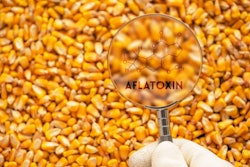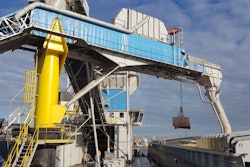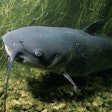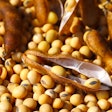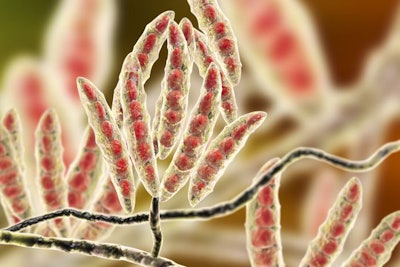
New tool from Innovad uses a drop of blood from an animal to determine how mycotoxin affect health and performance
PODCAST: Biomarker analysis adds new layer to mycotoxin monitoring (19:13)
Ann Reus: Hello and welcome to the Feed Strategy podcast. I’m your host, Feed Strategy staff reporter Ann Reus.
For years, there have been many testing tools to detect mycotoxins at various levels in crops, feed and raw materials. A new tool from Innovad uses a blood biomarker analysis to determine the mycotoxin risk and exposure to animals and how those mycotoxins affect an animal’s performance and health.
I spoke to Arnau Vidal, global technical manager at Innovad, about his company’s Myco-Marker product and how it works. We also discussed how biomarker analysis has been used to learn more about emerging mycotoxins and the correlation between mycotoxin exposure and clinical symptoms in animals, and mitigation strategies that can help counteract mycotoxins’ effects on animals.
Can you talk about Myco-Marker and how it works? How is it different from other mycotoxin testing tools?
Arnau Vidal: Yes, first of all, I think that it is interesting to have some words, a few words about how our work in the current mycotoxin testing tools, which mainly are feed analysis or raw material analysis. And all these mycotoxin testing tools are very important, but also everyone knows that they have some important limitations. So using these tools, it’s not possible to know which is the real mycotoxin exposure. And some of these limitations are for example, that mycotoxins are highly heterogeneous in the feed. Or for example, the big amount of concentrated forms that are not detected in the routine array analysis. For example, 50% of the total DON in the feed is in graduated forms or also more than 50% of the total fumonisins are graduated forms. So all this is ignored in the veterinary feed analysis, and for that reason it’s not possible to know the real mycotoxin exposure through this feed and raw material analysis.
Then, the last years, and thanks to the advances in analytical techniques, it is possible to analyze mycotoxin biomarkers. And the science demonstrated the last years that analyzing mycotoxin biomarkers is the best way to know the real mycotoxin exposure. So all these scientific evidence inspired Innovad to develop a more comprehensive mycotoxin testing tool that complements the feed analysis with biomarker analysis in the blood in animals. So for the reason, to summarize a little bit how works Myco-Marker service is the combination of feed analysis with 16 mycotoxins and mycotoxin biomarkers in blood, analyzing up to 36 different biomarkers. So, in other words, the combination of feed and blood that Myco-Marker is offering allows to know to the producers, which is for the first time, their real exposure to mycotoxins, and then find the correlation of this real exposure to mycotoxins with the impact of these mycotoxins in the animal health and animal performance. So, as you can see, the possibility to know the real threat to mycotoxins change completely the way that risk management of mycotoxins have been done until now.
Reus: How are samples taken and analyzed? And how are results accessed?
Vidal: Yes, also, this is very important because Innovad validated, and now is under patent, a method to analyze all these mycotoxin biomarkers using only one drop of blood, only 60 microliters. So, producers have to put this drop of blood on an FTA card that – I think that most of the people know what is the FTA card, but it’s just like a small piece of paper like less than 10 centimeters of paper, where in this paper there are different circles where the producer must put the drop of blood. And this is very important to use these cards because then there is no limitations of transportation or sending these blood cards, these blood samples using these FTA cards under refrigeration. So, you can send as you’re sending a normal mail and, once we receive the samples in our laboratory, we analyze them, and then we provide the results to the client. So, as you can see, it’s very easy to collect just feed sample, collect one drop of blood per animal, put in these cards and then we provide the results to the client.
Also, I would like here to remark how we transfer the results or how we inform of the results to the producers, because nowadays, more of the producers are get used to feed analysis results and they understand the mycotoxin results from the feed sample. But blood or biomarker analyses are still complicated to understand. And for that reason, we always have a meeting with the client or with the producer explaining what is the meaning of the results, and how we find the correlation with the risk level, thanks to the blood or the biomarker analysis. So as you can see, we also support to the producers to understand and interpret correctly the results.
Reus: How can poultry, livestock and feed producers utilize the results from the biomarker test? Can the results be used in conjunction with other mycotoxin monitoring?
Vidal: Yes, I think that there are mainly two different ways that the producers can use these Myco-Marker results. So first of all, as a diagnostic tool, so they have some problems in the farms, animals present some clinical symptoms, thanks to Myco-Marker service, thanks to this biomarker test, we can find the correlation with mycotoxin exposure and see the impact of the mycotoxins. So this is one way, as a diagnostic tool. And the second way, the second option is like a monitoring tool.
So, producers can send samples to us periodically, and then we can monitor the mycotoxin risk and, from there, optimize which is the best mitigation strategy to keep the performance level and always anticipate the position of health status problems of health clinical problems. And then of course, that can be used with other monitoring tools actually at Innovad, Myco-Marker is part of our mycotoxin control strategy. And other services that are offered in this mycotoxin control strategy are, for example, rapid test or LC/MS/MS, because Myco-Marker mainly is on the farm. So, we collect blood from the animals and we can even define which is the real mycotoxin exposure, specifically for each farm. But it’s also interesting for producers, for example, in feed mills to know which is the mycotoxin levels from raw materials to evaluate if they protect or not the raw materials if for example, the concentration is higher than what the legislation allows or higher than some internal thresholds. So for the reason also, we offer rapid test equipment to support them in this stage of the food chain are also we offer LC/MS/MS to combine with Myco-Marker and to know which is the mycotoxin risk in the feed samples. Because sometimes in the farm can be already too late to act, so also all these services that complete the mycotoxin management from the harvest to the farm with Myco-Marker.
Reus: What can producers do, then, in real time if troublesome results are found?
Vidal: They must act first, I’d say and also the best way to reduce the problems is apply some mitigation tools. For example, they must use detoxifiers and can reduce fast the exposure to mycotoxins and detoxify the animals. Here, I think that it’s very important to use technologies that demonstrated that they can work in real situation. Because most of the binders, they demonstrate some in vitro results, and in vitro results can be a first step to know how the technology will work. But they are not any guarantee of how they will work in real farm conditions, in the animal. So, even for example, the EFSA, the European Food Safety Agency, said that in vitro test doesn’t mimic the real conditions in the animal enough. So, it is necessary always to test in vivo how these detoxifiers can work.
For that reason, Innovad tested how our detoxification technologies work in the animal. And we demonstrated and we published in peer-reviewed journals that the usage of our detoxifier reduce significantly the systemic exposure to mycotoxins. So, in other words, if animals are consuming this technology, the levels of mycotoxins in blood will be lower. So it’s a clear demonstration that this technology protects the animal and avoids that mycotoxins can have an impact that’s toxic to the animals. So I think that producers must act, must use some binders from detoxifiers. But they always have to keep in mind to use technologies that work in vivo, in real situations.
Reus: Innovad conducted a global mycotoxin survey using Myco-Marker. Can you tell me when and how that survey was conducted and what were some of the key findings?
Vidal: So Myco-Marker was launched, like 15 months ago. And nowadays, we already analyzed more than 1,000 animals from all over the world. And all these analyses, all these more than 1,000 animals analyzed, allow to have a real picture of which is the mycotoxin exposure around the world. And yeah, I think that all this is a very highly valuable information because for the first time we have this information, and there are a lot of important results from all these surveys.
And for example, I think that one of the most important results is that mycotoxins have been detected in all the farms. So this demonstrates that mycotoxin risk is everywhere. And moreover, in more than 50% of the farms, five or more mycotoxins have been detected, and this is a concern because when there are two or more mycotoxins, there is a synergistic effect. So this means that the toxic impact of these mycotoxins will be higher than what was expected. So one first important result is that animals are continuously exposed to many mycotoxins at the same time. Another important finding is that blood provided very valuable information or blood is highly useful. Why? Because in 80% of the cases, it was detected and mycotoxin risk in the blood that was missed in the feed. So this clearly shows the importance of performing biomarker analysis to capture the real risk that is missed in the feed analysis.
Then another important point, and it was also surprising, is that the most frequent mycotoxins detected are emerging mycotoxins. It was known that emerging mycotoxins the last two, three years, different scientific field surveys demonstrated that they are highly common in the feed. But now, thanks to biomarker analysis, we demonstrated or we confirm that emerging mycotoxins are the most frequent mycotoxins detected in the farms.
Maybe it’s necessary to spend just a few seconds explaining what are these emerging mycotoxins because most of the people never heard about them. Just to say that they have not been detected or discovered, they have not been discovered now. They have been always been there. But now thanks to advances in analytical techniques, we can analyze them, and we realize that they are very, very common. For example, the most common mycotoxin detected in the blood was done with tenuazonic acid, which is produced by alternaria. For example, 68% of the analyzed pigs had presence of tenuazonic acid in the blood, or 66% of the poultry farms had presence of tenuazonic acid in the blood. Other highly common emerging mycotoxins, for example enniatins, or beauvericin, which are produced by fusarium. And also, I think that it’s important to mention that these emerging mycotoxins, although we don’t know a lot about the toxicity of these mycotoxins, the few information that we have clearly demonstrated that they are at least as toxic as the famous mycotoxins because, for example, it has been demonstrated that enniatins can be much more toxic than DON for intestinal cells from pigs, and everyone knows that DON is highly toxic for intestinal tissues. But, well, enniatins, we discovered a mycotoxin, or now we shed light on a mycotoxin that is as toxic as DON for intestinal tissues, is more toxic than DON, and no one is analyzing. So clearly demonstrates the importance of targeting, controlling all these mycotoxins that are called emerging mycotoxins to control the real mycotoxin exposure.
And then, also the last, I think, most important finding after analyzing all these 1,000 animals, is the correlation between mycotoxin exposure, real mycotoxin exposure detected, thanks to biomarker analysis and clinical symptoms detected in the animals. For example, in 83% of the cases were sows presented reproductive problems, the sows were exposed to zearalenone, which everyone knows this estrogenic mycotoxin, but they were also exposed to alternaria mycotoxins, which they can also be estrogenic mycotoxins. So as you can see, it’s also very important to target these emerging mycotoxins because they can also be the reason of the of the clinical problems that animals present in the farm.
So, I think that all these points that I discussed, they are highly important, and they clearly show the importance of analyzing blood to capture the real mycotoxin exposure, and the impact of this exposure in the animal performance and animal health status.
Reus: What do you think is the key takeaway message from your experience so far with this biomarker analysis?
Vidal: I think that biomarker analysis demonstrated that feed analysis is not enough and doesn’t allow to know which is the real mycotoxin risk. And now, thanks to biomarker analysis, we can quantify for the first time how big is the mycotoxin problem and, with this information, optimize for the first time, correctly, the mitigation strategy to protect the animals and improve the performance.
Reus: Thanks to Arnau for that very interesting analysis, and thank you to our listeners for tuning in. And remember, if you haven’t subscribed to the Feed Strategy podcast, you can do so wherever you get your podcasts.
Read more of Vidal’s insights in the November/December 2021 issue of Feed Strategy magazine.


